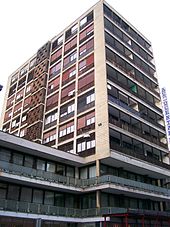- Drago Ibler
-
Drago Ibler Born August 14, 1894
ZagrebDied September 12, 1964
Novo MestoNationality Croatian Work Buildings District Labour Insurance Building Zagreb, District Labour Insurance Building Mostar, House Wellisch Zagreb, District Labour Insurance Building Skopje Drago Ibler (Zagreb, August 14, 1894; Novo Mesto, September 12, 1964) was a Croatian architect and pedagogue. His style can be described as pure simplicity and functional architecture.
He gained his Diploma of Architecture at the Technische Hochschule in Dresden. In 1921 he joined the group around Le Corbusier and L'Esprit Nouveau in Paris. Then studied from 1922-4 at the Staatliche Kunstakademie, Berlin, in the studio of German architect Hans Poelzig.
His firs significant project District Labour Insurance Building (1923), in Zagreb, was the first project to reflect the spirit of the modern architectural movement in Yugoslavia. Between 1925 and 1935 he established the so call Zagreb school of architecture with fellow architects Drago Galić, Mladen Kauzlarić, Stjepan Planić and others.
Drago Ibler was a fellow and protagonist of the social ideals of modern architecture as well as the aesthetics, and he founded the Earth Group (Croatian: Grupa Zemlja), with a group of left-oriented progressive artists. He was also a member of CIAM.
From the 1920s and 1930s Ibler worked on numerous architectural competitions, but with poor results due to conservative environment and resistance to his progressive ideas. In this time he executed villas on the island of Korčula and in Zagreb, several industrial buildings, the District Labour Insurance Building in Mostar, built in 1930 (Today the simple ambulance) this building has a beautiful convex half-ring-shaped entrance with a porch, and a dynamical balance of the low office building and the tall volume of the residential part and stairways.
After that he designed the District Labour Insurance Building (1932), Skopje, which was important for architecture in Yugoslavia, by introducing Le Corbusier's principles, including ribbon windows.
From 1926 Drago Ibler became a professor at the Zagreb Academy of Fine Arts, where he taught architecture until 1941. After that he relocated to Switzerland and joined the University of Geneva as a lecturer in architecture.
After the war 1950, he come again in Zagreb, and led a Master Studio in architecture and returned to teaching at the Academy of Fine Arts. After the World War II he started to be not so rigid functionalist and he encouraged the humanization of architecture by means of more decorative, sculptural and harmonious compositions, for example in his designs for the New Opera House (1948; unrealized) in Belgrade. He made excellent designs for the New Yugoslav Embassy in Moscow (1959; unrealized), and New Tito's Residence (1961- 4; unrealized) in Zagreb. Before his death in the automobile accident close to Novo Mesto in Slovenia, he designed several residential blocks in the centre of Zagreb, which are characterized by simplicity and functional planning, in Marticeva, Smiciklasova and Vlaska Streets.
References
Categories:- 1894 births
- 1964 deaths
- People from Zagreb
- Croatian architects
- University of Zagreb faculty
- Burials at Mirogoj Cemetery
Wikimedia Foundation. 2010.

